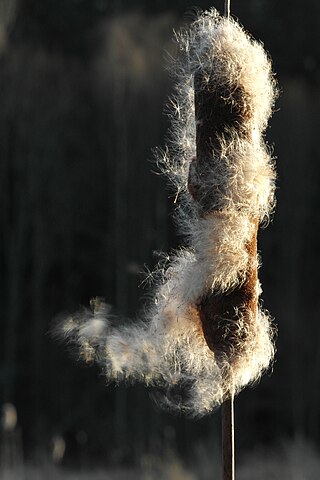
Typha is a genus of about 30 species of monocotyledonous flowering plants in the family Typhaceae. These plants have a variety of common names, in British English as bulrush or reedmace, in American English as reed, cattail, or punks, in Australia as cumbungi or bulrush, in Canada as bulrush or cattail, and in New Zealand as reed, cattail, bulrush or raupo. Other taxa of plants may be known as bulrush, including some sedges in Scirpus and related genera.

Cyperus papyrus, better known by the common names papyrus, papyrus sedge, paper reed, Indian matting plant, or Nile grass, is a species of aquatic flowering plant belonging to the sedge family Cyperaceae. It is a tender herbaceous perennial, native to Africa, and forms tall stands of reed-like swamp vegetation in shallow water.

Banksia petiolaris is a rare species of flowering plant in the family Proteaceae native to Western Australia, where it is found in sandy soils in the south coastal regions from Munglinup east to Israelite Bay. It was first described by Victorian state botanist Ferdinand von Mueller in 1864, and no subspecies are recognised. B. petiolaris is one of several closely related species that will all grow as prostrate shrubs, with horizontal stems and thick, leathery upright leaves. Those of this species can be viable for up to 13 years—the longest-lived of any flowering plant recorded. It bears yellow cylindrical flower spikes, known as inflorescences, up to 16 cm high in spring. As the spikes age, they turn grey and develop up to 20 woody seed pods, known as follicles, each.

Banksia hookeriana, commonly known as Hooker's banksia, is a species of shrub of the genus Banksia in the family Proteaceae. It is native to the southwest of Western Australia and can reach up to 4 m (13 ft) high and 3 m (9.8 ft) wide. This species has long narrow serrated leaves and large, bright flower spikes, initially white before opening to a bright orange that appear over the cooler months. The flowers are pollinated by honeyeaters. The ageing flower spikes develop woody seed pods known as follicles. B. hookeriana is serotinous — large numbers of seeds are stored in the plant canopy for years until the plants are burnt by bushfire.
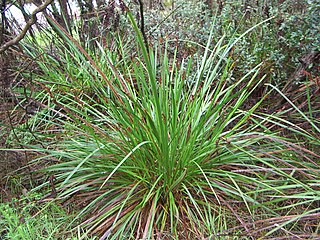
Lepidosperma gladiatum is commonly known as the coast sword-sedge or coastal sword-sedge. It is an evergreen species of sedge that is native to southern coastal areas of Australia. It was described by French botanist Jacques Labillardière in 1805. The Noongar name for the plant is kerbein.

Rhynchospora alba, the white beak-sedge, is a plant in the sedge family, Cyperaceae. It is a tufted herbaceous perennial around 50 cm tall, with white inflorescences that flower in August. The fruit of the sedge is a small achene with a characteristic beak-like cap. It is dispersed by wind or falls by gravity, leading to individuals existing in tight clumps. The species favours wet, acidic and nutrient poor soils, thriving in Sphagnum-dominated bogs, but also peaty grasslands. As such it is often used as a positive indicator for bog and mire ecosystem health.

Lepidosperma is a genus of flowering plant of the family Cyperaceae. Most of the species are endemic to Australia, with others native to southern China, southeast Asia, New Guinea, New Caledonia and New Zealand.

Lepidosperma longitudinale is commonly known as the pithy sword-sedge or pith saw-sedge. It is an evergreen species of sedge that is native to swampy areas of most Australian states. It was described by French botanist Jacques Labillardière in 1805.

Gymnoschoenus sphaerocephalus, commonly known as buttongrass, is a species of tussock-forming sedge from southeastern Australia. It forms part of a unique habitat in Tasmania.

Lepidosperma laterale, commonly known as the variable swordsedge, is a plant found in south-eastern Australia, New Caledonia and New Zealand. It is often found on sandy soils or rocky areas in wooded areas.
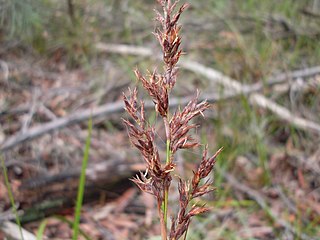
Lepidosperma concavum, commonly known as the sandhill sword-sedge, is a plant found in coastal regions of south-eastern and eastern Australia. It grows on sandy soils in woodland, forest and heathland.

The swamp communities of the Blue Mountains are a geographically dispersed group of ecologically-endangered peat swamp communities, spanning multiple parts of the World Heritage-listed Blue Mountains National Park in New South Wales, Australia.
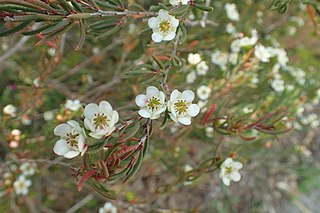
Chamelaucium axillare, commonly known as Esperance waxflower, is a species of flowering plant in the family Myrtaceae endemic to Western Australia.

Machaerina juncea, commonly known as bare twig-rush or tussock swamp twig rush, is a sedge in the sedge family, Cyperaceae, that is native to Australia, New Zealand, and New Caledonia.
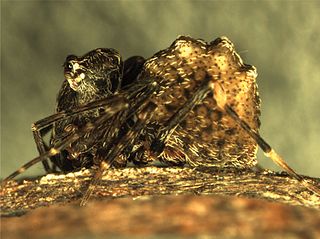
Zephyrarchaea mainae is a species of spider, informally known as Main's assassin spider, Albany assassin spider, and the Western archaeid spider. The first of the assassin spider family found in Western Australia, the species was unknown until its collection at Torndirrup National Park near Albany was published in 1987.

Lake Vancouver is a permanent freshwater lake in the Great Southern region of Western Australia located approximately 20 km (12 mi) south east of the town of Albany and about 438 km (272 mi) south east of Perth. The lake is listed in the South Coast significant Wetlands database and is part of a case study to help determine buffer zone guidelines for wetlands in Western Australia.

Lepidosperma leptostachyum is a species of flowering plant in the sedge family, Cyperaceae, a native of Southwest Australia.

Atriplex stipitata, commonly known as mallee saltbush, bitter saltbush and kidney saltbush, is a species of shrub in the family Amaranthaceae, found in all mainland states of Australia.

Oreobolus pumilio, commonly known as alpine tuftrush or Ibrang`rank, is a small mat forming herb which is distributed throughout the Australasian region. It is a relative of the sedge. It is often found in cushion plant communities, in alpine environments, where it is a dominant species. As a cushion plant, it is an ecological engineer and enables other species to grow in the alpine herblands to which it is native to.

Schoenus nanus is a species of sedge endemic to Australia, and found in Western Australia, South Australia and Victoria. It was first described in 1844 by Christian Gottfried Daniel Nees von Esenbeck as Chaetospora nana, but in 1878 was transferred by George Bentham to the genus, Schoenus.




















